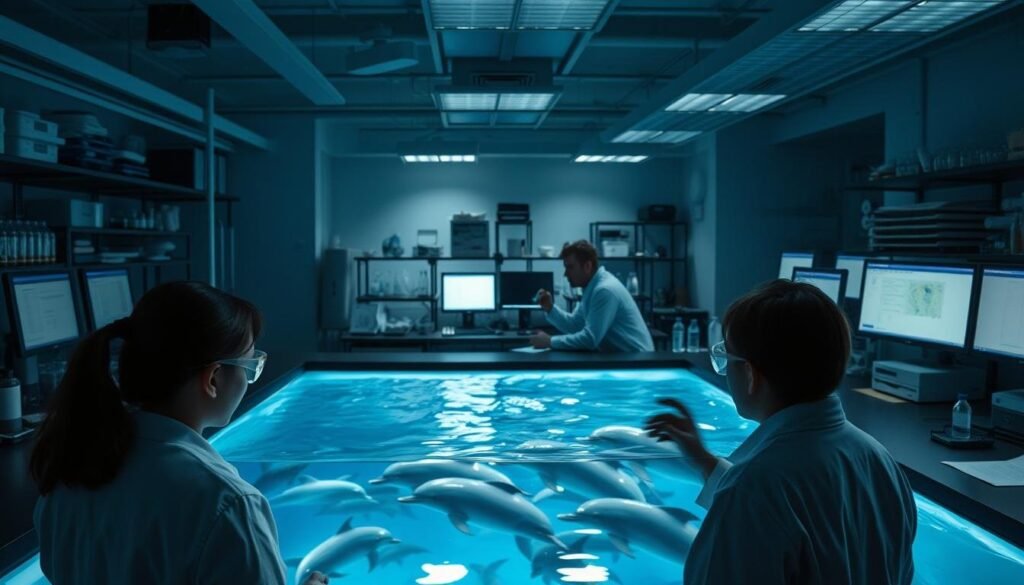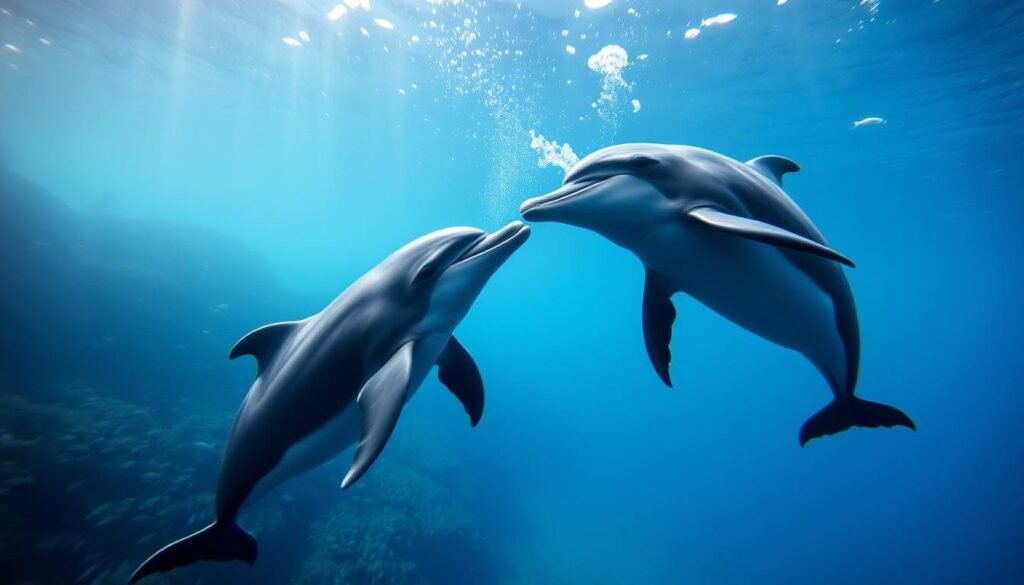Is it a Crime to Communicate with Dolphins? Have you ever thought about if it’s legal to talk to dolphins? It’s important to know the laws about dolphin communication when we interact with them.
Laws protect dolphins and their homes. They help keep dolphins safe, but they also make us wonder about our limits with human-dolphin interactions.
Exploring this topic will show you how laws protect marine mammals. You’ll see how these laws affect people who talk to dolphins.
Contents
- 1 Understanding Dolphin Communication and Intelligence
- 2 Marine Mammal Protection Laws in the United States
- 3 Is It a Crime to Communicate with Dolphins? Legal Analysis
- 4 Scientific Research Exceptions and Protocols
- 5 Ethical Considerations Beyond Legality
- 6 Responsible Ways to Experience Dolphin Communication
- 7 Conclusion: Is it a Crime to Communicate with Dolphins?
- 8 FAQ
Understanding Dolphin Communication and Intelligence
Dolphins are known for their smarts and complex social lives. Their ability to talk to each other in detailed ways is quite fascinating.
How Dolphins Communicate
Dolphins use clicks, whistles, and body language to talk. Their way of communicating is advanced. They share info about food, who’s in charge, and even how they feel.
Some of the ways dolphins communicate include:
- Using specific clicks and whistles to identify themselves or signal others.
- Employing body language to convey emotions or intentions.
- Creating complex vocalizations to coordinate hunting efforts.
They also show their intelligence in their social lives. Dolphins form strong bonds and pass on cultural traditions. This complex social structure is a hallmark of their intelligence.
Marine Mammal Protection Laws in the United States
In the United States, the Marine Mammal Protection Act (MMPA) is key in saving marine mammals. It was passed in 1972. The MMPA aims to protect marine mammals by controlling human actions that harm them.
The MMPA stops people from harming marine mammals. This includes hunting, capturing, killing, or disturbing them. This rule is for both U.S. citizens and people from other countries in U.S. waters.
Prohibitions and Exceptions Under the MMPA
Even though the MMPA has strict rules, it also has some exceptions. These include:
- Scientific research: Permits are given for research that helps marine mammals.
- Public display: Places can get permits to show marine mammals for learning or conservation.
- Incidental take: Permits are given for taking marine mammals by accident during activities like fishing or naval operations.
| Activity | MMPA Provision | Permit/Authorization Required |
|---|---|---|
| Scientific Research | Allowed for conservation or understanding | Yes, Scientific Research Permit |
| Public Display | Allowed for education or conservation | Yes, Public Display Permit |
| Incidental Take | Allowed for unintentional takes during specified activities | Yes, Incidental Take Authorization |
The MMPA is very important. It helps balance human activities with protecting marine mammals. Knowing its rules is key for following the law and helping marine mammals.
Is It a Crime to Communicate with Dolphins? Legal Analysis
Exploring dolphin communication raises legal questions. Laws about talking to dolphins vary by place.
In the U.S., the Marine Mammal Protection Act (MMPA) is key. It stops people from bothering, hunting, or killing marine mammals like dolphins.
Legal cases offer insights into dolphin interactions. For example, United States v. Hayashi found feeding wild dolphins is a crime under MMPA.
| Case | Ruling | Implication |
|---|---|---|
| United States v. Hayashi | Feeding wild dolphins is harassment under MMPA | Prohibits feeding dolphins |
| NMFS v. Sea Life, Inc. | Keeping dolphins in captivity requires special permits | Regulates dolphin captivity |
Communicating with dolphins can lead to legal trouble. Knowing the laws helps protect both humans and dolphins.
To avoid legal issues, follow all laws and rules. This means getting the right permits for dolphin interactions, like in research or education.
Scientific Research Exceptions and Protocols
Researchers studying dolphins face a complex set of rules and ethics. It’s vital to understand dolphins’ behavior, social lives, and where they live. But, they must follow strict rules to protect these smart animals.
To study dolphins, researchers need permits from the right places. These permits depend on the study’s worth, the researchers’ skills, and how it might affect dolphins.
Ethical Protocols for Studying Dolphins
There are rules to keep dolphins safe in their homes. Researchers must follow these to avoid harming them. This way, their studies help us learn more about dolphins and how to save them.
| Research Aspect | Protocol | Permit Requirement |
|---|---|---|
| Observational Studies | Minimize disturbance, maintain distance | Yes, for long-term studies |
| Experimental Research | Ensure no harm, obtain informed consent where applicable | Yes, with detailed justification |
| Conservation Studies | Collaborate with conservation bodies, follow guidelines | Yes, with conservation goals |
The balance between advancing scientific knowledge and protecting dolphin welfare is crucial. By sticking to the rules and getting the right permits, researchers can help us learn more about dolphins. They do this while making sure dolphins are safe.

Ethical Considerations Beyond Legality
Ethical thoughts are important when we interact with dolphins. It’s crucial to think about how our actions affect their well-being.
Dolphins face many welfare concerns. These include their living conditions, social lives, and how humans affect them. Responsible interaction helps reduce harm and makes experiences better for both humans and dolphins.
Ethical Guidelines for Human-Dolphin Encounters
To have ethical dolphin encounters, follow these guidelines:
| Guideline | Description | Benefit |
|---|---|---|
| Maintain a safe distance | Keep a safe distance to avoid stressing the dolphins | Reduces stress on dolphins |
| No touching or feeding | Avoid touching or feeding dolphins in the wild | Prevents habituation and maintains natural behavior |
| Observe, don’t interact excessively | Limit the duration and frequency of interactions | Minimizes disruption to dolphin activities |
Following these guidelines helps make human-dolphin interactions more ethical. It ensures the well-being of these amazing creatures.
Responsible Ways to Experience Dolphin Communication
Exploring dolphin communication requires care and thought. Responsible dolphin watching means more than just seeing them. It’s about making sure they stay safe and healthy.
Tour operators and visitors must follow guidelines for dolphin interaction. These rules help protect dolphins and their homes. For example, keeping a safe distance is key to not scare them.
Best Practices for Interacting with Dolphins
- Keep a safe distance from dolphins to avoid stressing them out.
- Never feed dolphins in the wild, as this can disrupt their natural feeding habits.
- Be aware of your surroundings and the dolphins’ behavior to ensure a safe interaction.
By sticking to best practices for dolphin encounters, you help protect these smart animals. This means choosing tours that are kind to dolphins and the sea.
Responsible dolphin watching makes your visit better and helps the dolphins too. It’s about having a good time while also showing respect and care for these amazing creatures.
Conclusion: Is it a Crime to Communicate with Dolphins?
You now know a lot about human-dolphin interactions. Laws about dolphin communication are complex. They involve protecting marine mammals and exceptions for scientific research.
When you interact with dolphins, think about the laws and ethics. A summary of guidelines shows we must be respectful and responsible.
Knowing the rules and best practices helps protect dolphins. As you learn about dolphin communication, always put their well-being first.
See Also: Is It a Crime to Not Go to School?
FAQ
What is the Marine Mammal Protection Act (MMPA)?
The MMPA is a law that protects marine mammals like dolphins. It stops humans from harming, harassing, or killing them. It also controls how we interact with these animals to help keep their numbers safe.
Can I communicate with dolphins in the wild?
Yes, you can meet dolphins in the wild. But, you must follow rules to not disturb them. Feeding, touching, or swimming with them can hurt them and is often not allowed.
How do researchers obtain permits to study dolphins?
Researchers need to apply for MMPA permits to study dolphins. They must explain their study plans and how they will protect the dolphins. The application goes through checks by groups like the National Marine Fisheries Service.
What are the consequences of violating the MMPA?
Breaking the MMPA can lead to fines, penalties, and even jail time. The punishment depends on how serious the offense is and the harm done to the dolphins.
Can I keep dolphins in captivity?
Keeping dolphins in captivity is tightly controlled. It’s mainly allowed for places like zoos or research centers that meet high animal care standards.
How do dolphins communicate with each other?
Dolphins talk to each other with clicks, whistles, and body language. This lets them share detailed info and work together.




